Have you been wondering how to choose a diamond ring – and where to start? If you’re embarking on the exciting journey of selecting a diamond for an engagement ring – and are not quite sure where to start – you’ve come to the right place!
I remember when my husband and I first started talking about engagement rings. We didn’t have the faintest clue what we were looking for or where to start. We were nervous about making such a big investment without first having a base understanding of diamonds. Thankfully, Kyle’s uncle is an amazing jeweler out in Michigan and he helped walk us through everything we needed to know to feel confident in our decision. (Shoutout to Brian at Larson Jewelry Design – and for my dream custom ring!)
Diving into the world of diamonds can feel like navigating a glittering galaxy of choices… and the terminology itself can sometimes be confusing. So, I wanted to break down how to choose a diamond by guiding you through the 4 Cs, the popular shapes and settings, diamond options/alternatives and the metals that set the stage for these stars to shine and so much more. And all in a way that’s simple and easy to digest! (Not to mention, some very pretty engagement ring and wedding band inspiration!)
But, first, let’s talk about “why diamonds”?

Why Diamonds?
Why have these precious gems become synonymous with the promise of forever? Here are the top few reasons:
Symbol of Eternity: Diamonds are the hardest natural material on Earth, and their indestructibility has come to symbolize the unbreakable bond of love and commitment. This enduring quality makes them a perfect metaphor for a lasting marriage. But also, being the hardest natural material (ranking 10 on the Mohs Hardness Scale – more on that below), it means you don’t have to worry about it scratching. Which is a point of serious relief for those of us who are generally rough with our hands.
Historical Significance: While the 20th century saw a surge in the popularity of diamond rings, propelled by a combination of clever marketing and the glamour of Hollywood. (Phrases like “A Diamond is Forever” helped link diamonds to the idea of a timeless, unbreakable love.) The tradition of diamond engagement rings actually dates back to the 15th century!
It was believed that a vein ran directly from the fourth finger on the left hand to the heart. (The ancient Romans had even dubbed it the “vein of love” – alas this has since been disproved. But, it’s still cute nonetheless!) So, placing a diamond on this finger has since symbolized a connection directly to the heart.
While diamonds have become the traditional choice, it’s important to remember that the most important factor in choosing an engagement ring is what it represents to you and your partner. Whether it’s a diamond, another of your favorite gems or no gem at all, the true value of an engagement ring lies in the love and commitment it symbolizes. So, as you embark on this journey, remember that your love story is unique, and your ring, whatever it looks like, is a reflection of your shared journey, dreams and promises.
Now, let’s dive into how to choose a diamond – and what all you need to know!
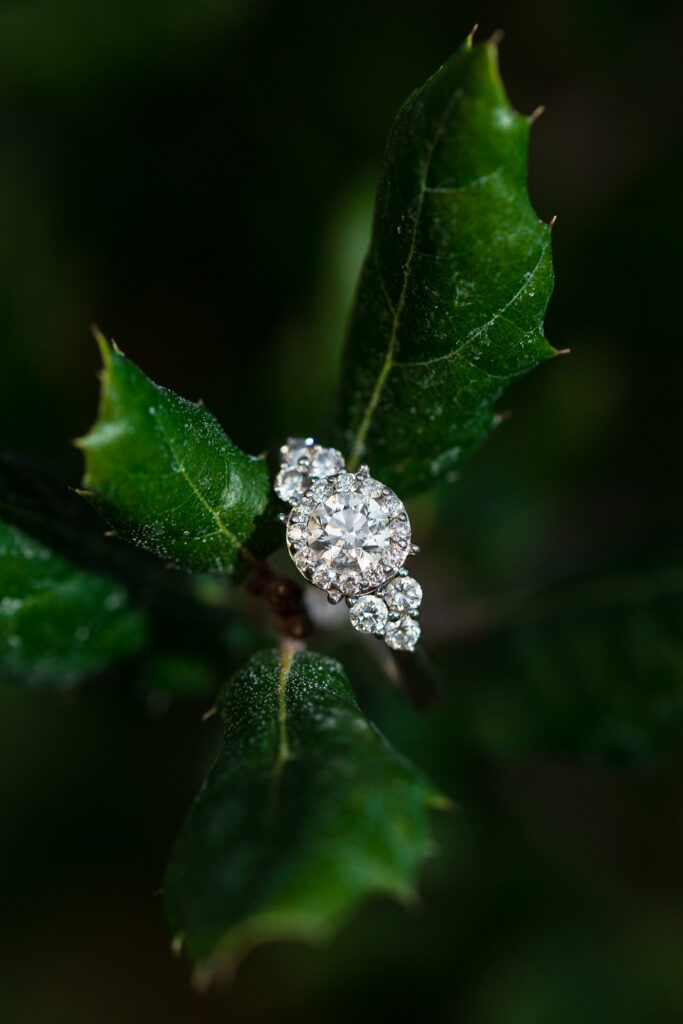
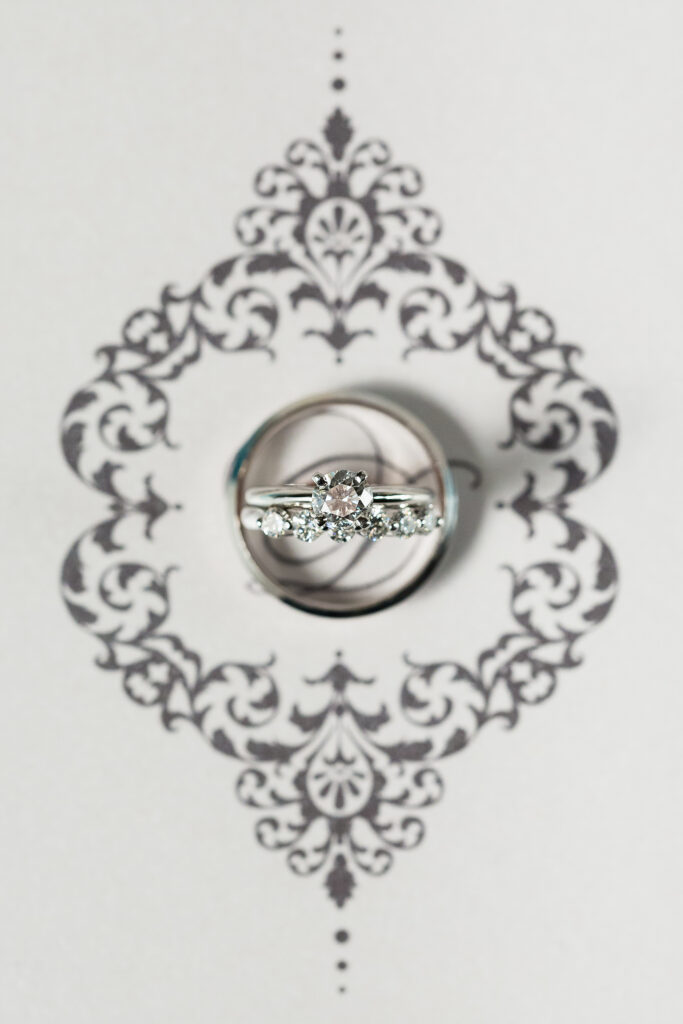
The Mohs Hardness Scale
When I first started my journey into choosing my engagement ring, I initially thought I wanted a more unique gem (like a ruby, as both my husband and I adore the color red!) I felt some resistance to choosing a diamond by default, just because everyone else did. However, after learning about the Mohs Hardness Scale… and realizing that diamonds bring with them neutrality (not having to worry about matching any of my clothing or other jewelry to it daily)… I understood the appeal of the diamond. And the peace of mind it brought with it.
This scale, ranging from 1 (softest) to 10 (hardest), measures a gemstone’s scratch resistance- and is crucial to consider for pieces exposed to daily wear and tear. Diamonds, at the top with a rating of 10, can scratch any other material, while lower-rated minerals are more susceptible to scratches, affecting their longevity in jewelry.
If you’re looking for a good resource that dives deeper into this scale, check this one out! For example: where does Amber fall on the Mohs Hardness Scale – and how easy is it to scratch? (Spoiler alert: Amber is rated as a 2-2.5 and could be scratched by a fingernail!) As you can see, this is very helpful information to have before committing to any gem!

The New Age Trio: Natural Diamonds, Lab-Grown Diamonds, and Moissanite
The choice between natural diamonds, lab-grown diamonds, and moissanite is deeply personal. Each has its own unique attributes and considerations. These are the 3 most common diamond (or diamond replacement, for Moissanite) options I see in the world today and wanted to shed some light on each.
1. Natural Diamonds
Pros:
- Uniqueness: Each natural diamond is unique with its own set of characteristics and inclusions, making it a one-of-a-kind symbol of your love.
- Investment: Natural diamonds have traditionally held their value over time and can sometimes even appreciate in value, making them a potential investment.
Cons:
- Price: Natural diamonds are typically the most expensive option due to their rarity and the extensive mining process.
- Ethical Concerns: Mining for natural diamonds has been associated with environmental impact and ethical concerns, though choosing a diamond certified by responsible mining initiatives can mitigate this.
2. Lab-Grown Diamonds
Pros:
- Quality and Beauty: Lab-grown diamonds possess the same physical, chemical, and optical properties as natural diamonds, ensuring the same sparkle and durability. They are, quite literally, diamonds – just created under pressure in a lab, instead of formed over billions of years in the Earth.
- Affordability: Generally, lab-grown diamonds are less expensive than natural diamonds of similar size and quality, offering more budget-friendly luxury.
- Ethical and Sustainable: Lab-grown diamonds offer a more sustainable and ethical choice, as they require no mining and have a smaller environmental footprint.
Cons:
- Perceived Value: Some may perceive lab-grown diamonds as less valuable or prestigious than natural diamonds, although this perception is changing rapidly.
- Resale Value: Lab-grown diamonds may not retain their value as well as natural diamonds, making them less ideal as an investment. However, as the perception of them continues to change, this is predicted to change as well. As they are, in fact, just diamonds.
3. Moissanite
Pros:
- Brilliance and Fire: Moissanite is known for its incredibly high brilliance and fire (rainbow flashes) than even the most perfect natural diamonds.
- Affordability: Moissanite is significantly less expensive than either diamond option, offering a cost-effective option for those seeking a diamond-like appearance.
- Durability: With a hardness of 9.25 on the Mohs scale (discussed above), moissanite is highly resistant to scratching and suitable for everyday wear.
Cons:
- Disco Ball Effect: Some find the high brilliance and fire to be too much. It can look like a rainbow disco ball and for some, gives the feeling of a distracting and cheaper stone.
- Color Tint: Some moissanite stones can exhibit a slight yellow or gray tint, especially under certain lighting conditions or in larger sizes, though newer versions have greatly improved in colorlessness.
- Perception: Some may not view moissanite as prestigious or traditional compared to natural diamonds, although it’s gaining popularity as a diamond alternative. Not that this should matter.
When considering natural diamonds, lab-grown diamonds, or moissanite, reflect on what matters most to you. Is it the timeless value and uniqueness of a natural diamond, the ethical and sustainable beauty of a lab-grown diamond, or the affordable brilliance and durability of moissanite? There is no wrong or right here – only what suits you best.

Understanding the Sparkle: The 4 Cs of Diamonds
The 4 Cs. These are how diamonds are graded and categorized. The 4 Cs stand for Cut, Color, Clarity, and Carat. Each of these characteristics plays a role in a diamond’s appearance and overall worth, helping to guide you toward making the best choice for you. As we explore each ‘C’ in more depth, you’ll better understand what you’re looking for, at and how to choose a diamond that suits you best.
- Cut: The cut isn’t about the shape of the diamond (eg: round, oval, or heart), but rather how the diamond’s facets interact with light. Precision in the cut of a diamond ensures that light enters and exits the diamond in such a way that it dances before your eyes. A well-cut diamond will have tremendous brilliance, sparkle and fire. This scale ranges from Super Ideal (or Excellent) to Poor.
- Color: Diamonds come in a kaleidoscope of colors. However, with traditional white diamonds, the goal is often to have as little color as possible. The color scale ranges from D (colorless) to Z (light yellow or brown). Colorless diamonds are the rarest and, therefore, the most valuable. However, some of the most beautiful diamonds showcase a hint of color, bringing its own unique charm.
- Clarity: This refers to the natural imperfections, known as inclusions (internal) and blemishes (external), found in diamonds. The clarity scale ranges from Flawless (no inclusions or blemishes visible under 10x magnification) to Included (inclusions and/or blemishes are obvious under 10x magnification and may affect transparency and brilliance). Remember, inclusions are like birthmarks; they make each diamond unique. Sometimes, they can even add character without compromising the gem’s natural beauty.
- Carat: This is about the weight, not the size, of the diamond. Higher carat weight typically results in a larger diamond. But, depending on the shape, this can be deceiving.
Remember, it’s not just about size but about the harmony of all four Cs working together to create something magical. Let your personal preferences help guide you to the perfect diamond for you.

Diamond Shapes
A diamond’s shape refers to the geometric appearance of a diamond (often confused with its “cut”, as explained above). Some of the most popular shapes are: Round Brilliant, Princess, Cushion, Emerald, Oval, Marquise, Asscher, Radiant, Pear and Heart.
Each shape has its unique charm and characteristics, and yes, some shapes can be more budget-friendly than others due to various factors like demand, cutting waste, and the raw diamond’s original shape.
While round brilliants are usually the most expensive shape due to their high demand and cutting waste. The other shapes, often referred to as ‘fancy shapes,’ can provide beautiful alternatives at a reduced cost. The price also depends on the rough diamond’s original shape and how much is wasted during cutting.
With that said, there is no right or wrong answer when it comes to choosing your perfect shape. It boils down to taste and personal aesthetic. Consider what resonates with your style and the message you want your ring to convey.

Diamond Ring Settings
The setting of a diamond not only secures your precious gem but also enhances its beauty, brilliance, and visibility. The right setting can simultaneously elevate the appearance of your diamond and ensure its safety. So let’s chat about 6 of the most popular setting options and the nuances of choosing one over the other (including the debate between 6 prongs and 4).
1. Prong Setting
The most common and classic setting, prongs are metal claws that hold the diamond securely in place. They can vary in number and style. The prong setting elevates the diamond, maximizing the amount of light that enters and exits, enhancing its sparkle. (Be sure to make note of how high your diamond sits off your finger from a practical standpoint as well. Some settings will have the diamond sitting up higher and others sitting down closer to your finger. I specifically asked that mine be set lower, because I was afraid it was going to catch things too easily sitting too high up.)
- 4 Prongs vs. 6 Prongs: A 4-prong setting allows more of the diamond to be seen and can make the diamond appear larger and more prominent. However, a 6-prong setting offers more security for the diamond, especially for larger stones, and can create a rounder visual appearance for the diamond. If you have an active lifestyle or want extra security for your gem, 6 prongs might be the way to go. But this will come down to your aesthetic preferences and your jeweler’s recommendation for your specific diamond and ring.
2. Pavé Setting
Small diamonds are set closely together around the band, secured with minimal metal, and appear to be paved on the surface. This keeps the visibility of metal to a minimum. Pavé settings add extra sparkle to your ring and can make the center stone appear larger.
3. Channel Setting
Diamonds are set into a channel made in the band of the ring, providing a sleek, modern look with additional protection for the diamonds. It’s typically a great choice for wedding bands or rings with side stones.
4. Three-Stone Setting
Typically, a larger center stone is flanked by two smaller stones. This setting is rich in symbolism, often representing the past, present, and future of a relationship. It offers a balance of sparkle and size and can be personalized with various diamond shapes and colors.
5. Halo Setting
The center diamond is encircled by a collection of round pavé diamonds. This setting makes the center stone appear larger and increases the overall sparkle of the ring. This is a great option for those wanting the visual of a larger diamond, but not the expense.
6. Bezel Setting
In this setting, a metal rim encircles the diamond, holding it in place. The bezel setting is one of the most secure settings and is a great choice for an active lifestyle. It provides a sleek, modern look but can slightly reduce the diamond’s brilliance by covering more of its surface.
When choosing a setting, consider not only the beauty and style but also the practicality. If you lead a very active lifestyle, a more secure setting like the bezel or a higher number of prongs might be ideal. For those seeking to make a statement with sparkle, settings like 4 prongs, pavé, halo, or three-stone can add additional brilliance and dimension.
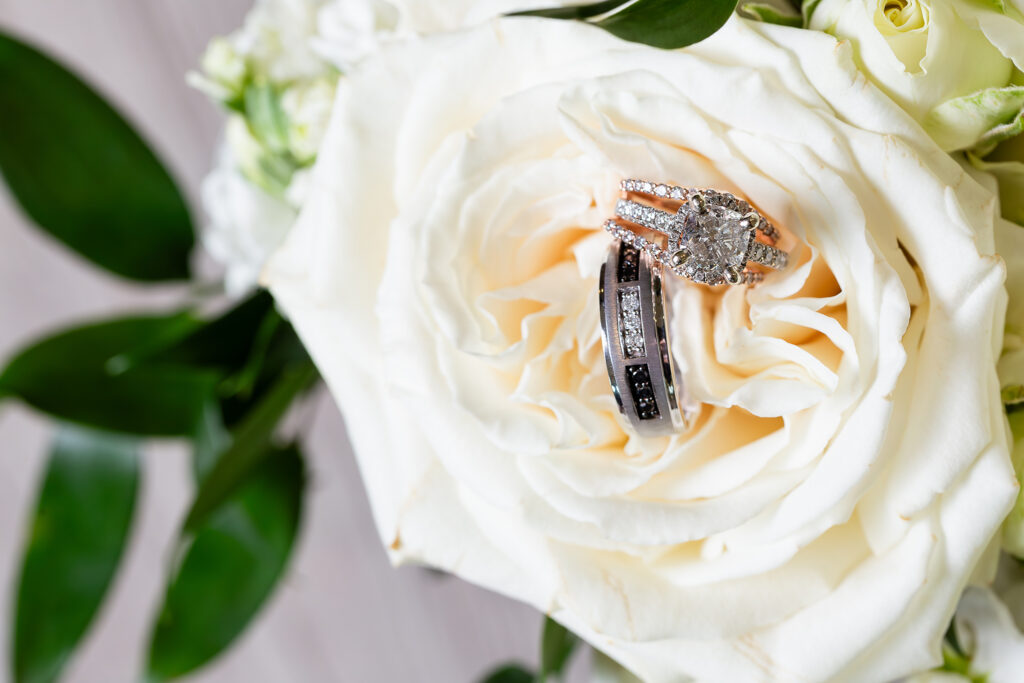
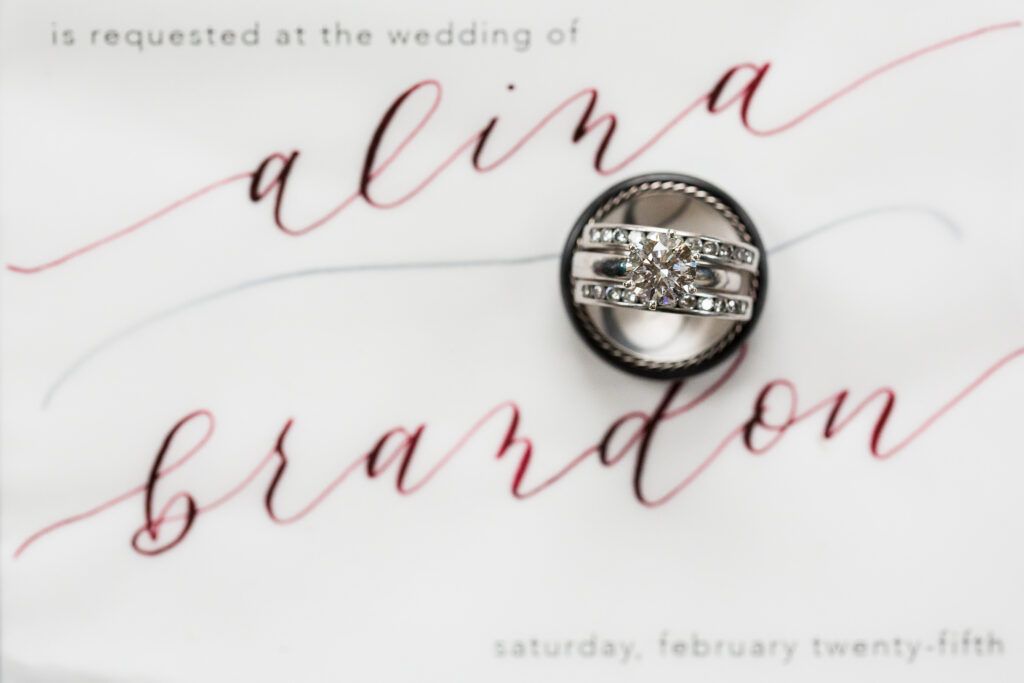
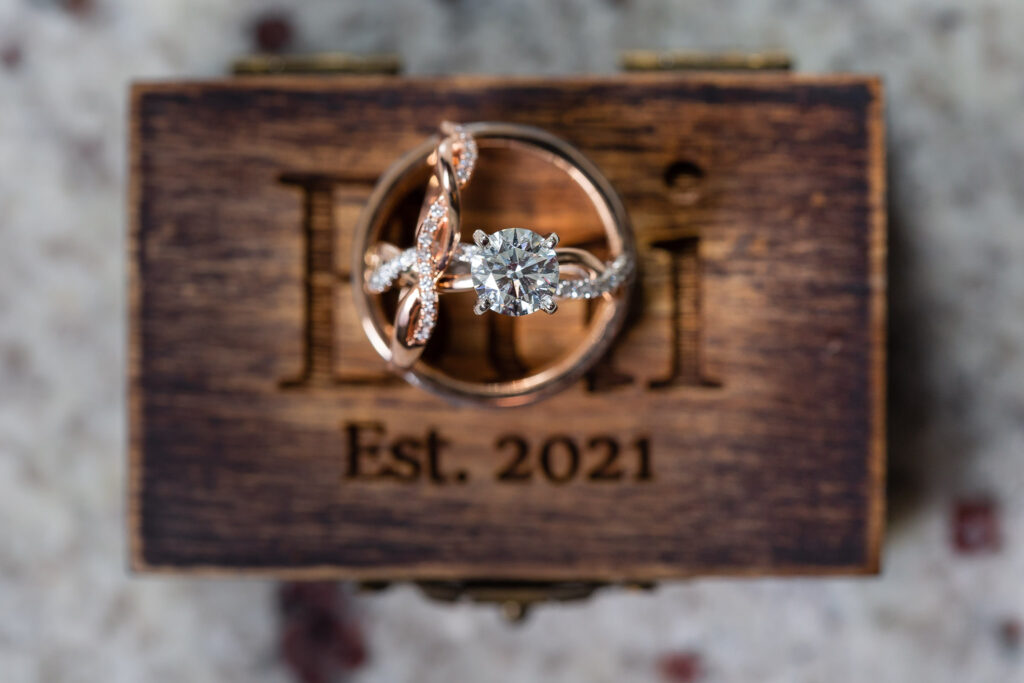
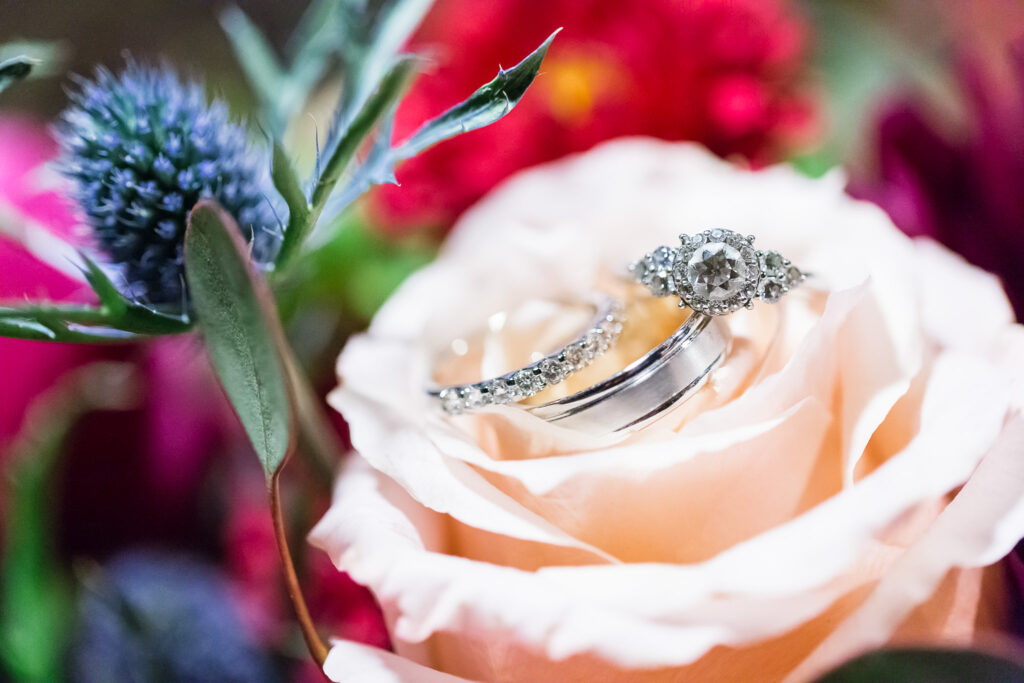
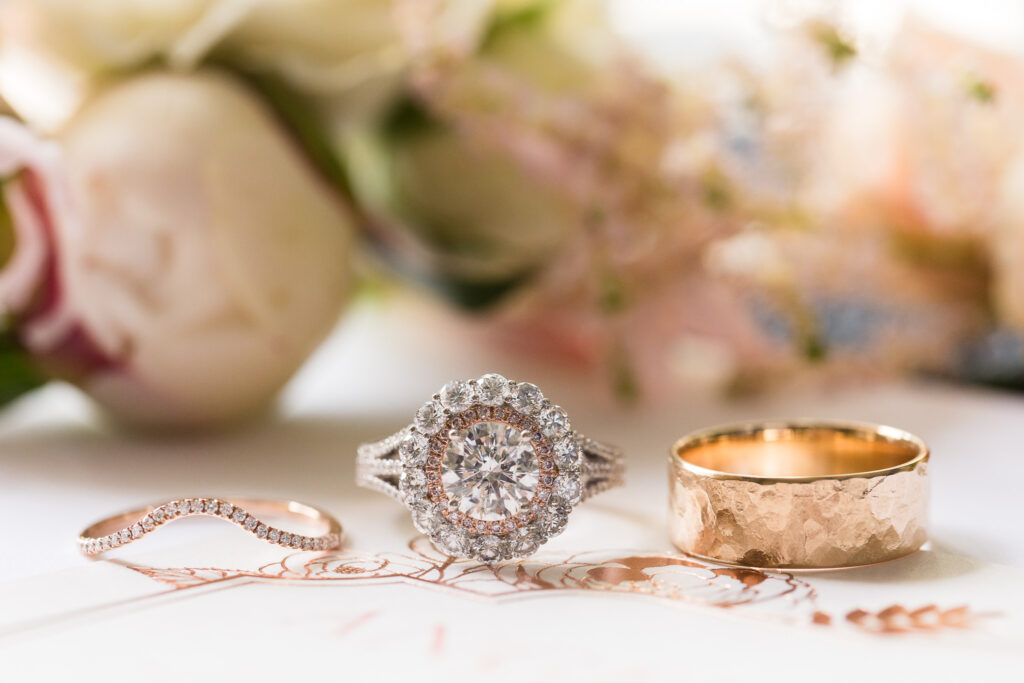
Choosing the Right Metal
The metal you choose sets the stage for your precious diamond. It can accentuate its brilliance, complement your skin tone, and resonate with your personal style.
- Platinum is luxurious and durable but will be on the heavier and pricier side. It’s naturally white and doesn’t cast any color onto your diamond. However, despite being more durable, platinum is actually a softer metal than 14k gold. So, it is more prone to scratches and damage on the surface. It will also patina over time (what gives it that antique look – although you can polish it back to a smooth shiny metal). Its softness is what makes it a more appropriate metal choice for detailed engraving work. And its durability for holding bigger stones.
- Gold is another classic choice. Available in various hues – yellow, white, and rose – gold is versatile. And cheaper. White gold, with its silvery look, is almost identical to platinum. It’s coated in rhodium for durability and shine, though it may need recoating over time. (What’s great about this option is you can re-plate it at any time to get that perfect flawless shine back whenever you want – without polishing away the metal over time like with platinum). It is less prone to bending, making it slightly more secure for setting gemstones – especially smaller ones. Yellow gold is timeless, offering a warm glow, while rose gold brings a unique, romantic touch.
- Silver is not as common for engagement rings, but is a more affordable option. It is much softer and more prone to damage than either platinum or gold. And it also requires more maintenance to prevent tarnishing.

Final Thoughts
Armed with knowledge about the 4 Cs, diamond options, shapes, settings and the perfect metal, I trust that you’re well on your way to finding the perfect engagement ring for you! Just a few quick last thoughts. When you walk into that jewelry store, remember:
- Ask for a certificate and appraisal: A diamond certification from a reputable organization assures you of your diamond’s quality and characteristics. An appraisal is a document that details the specifics of your ring—the type of diamond, the 4 Cs, the metal of the band, and the ring’s total value. The appraisal is crucial for getting your ring insured. They will ask for this document – so be sure to have it and keep it safe! (And then get your ring insured ASAP for peace of mind!)
- See it in different lights: Observe your diamond in various lighting conditions. Look at it under a light, around the shop and even outside to see it in sunlight. It will look different under varying light conditions – make sure you love them all!
- Trust your instincts: While the 4 Cs are important, the most important thing is how the diamond makes you feel. It’s a symbol of your love and journey together. Choose one that resonates with you.
Curious how to care for and keep your ring clean once you have it? Check out this quick blog on how to clean your diamond ring!
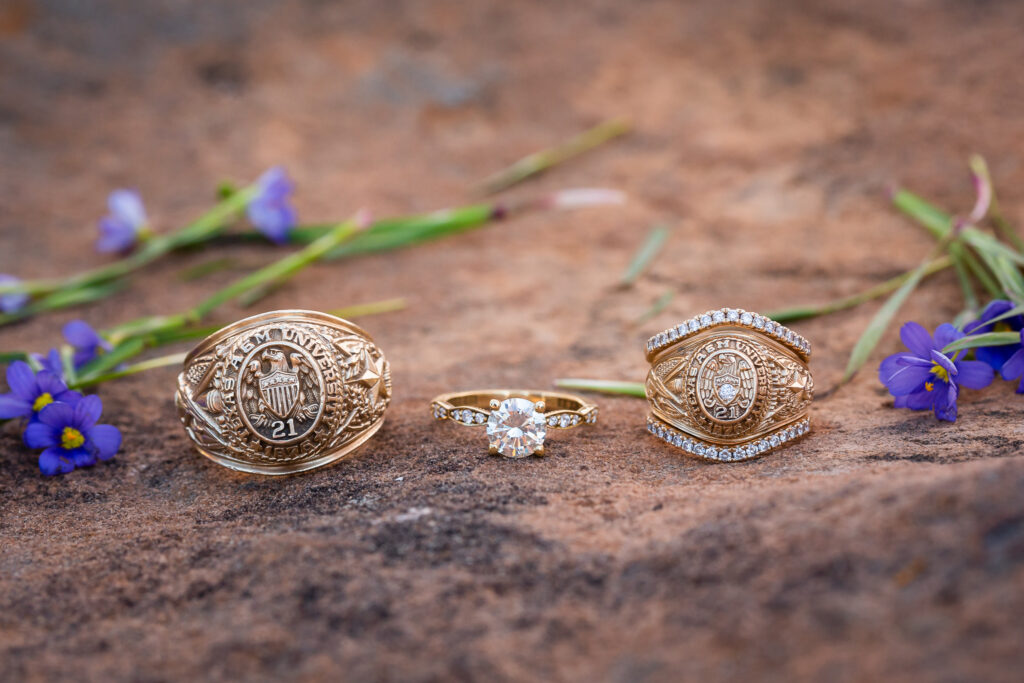
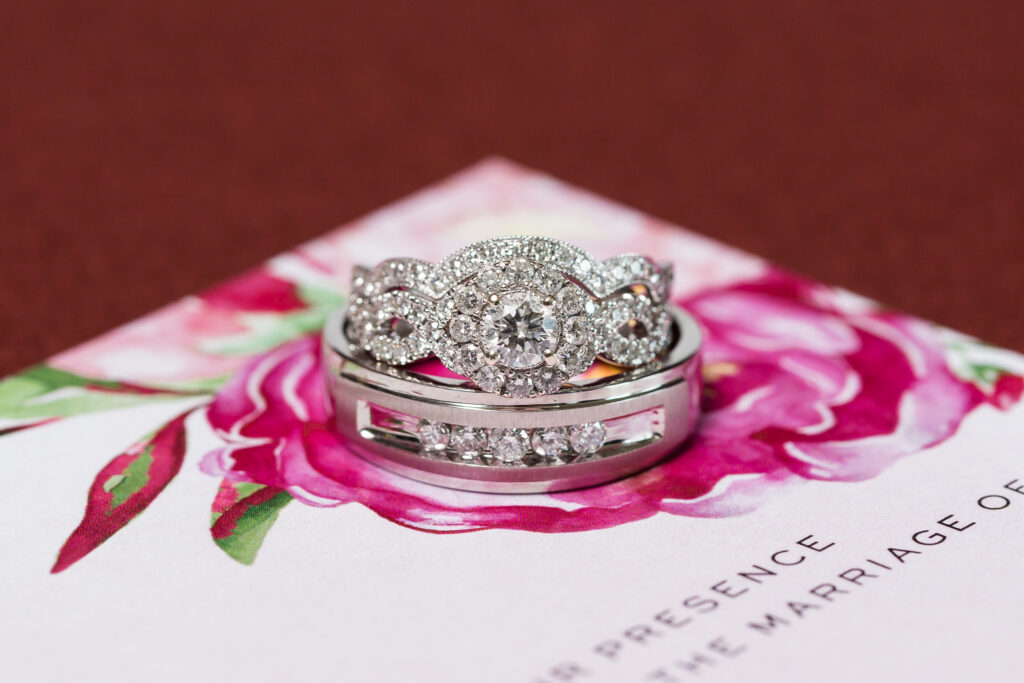
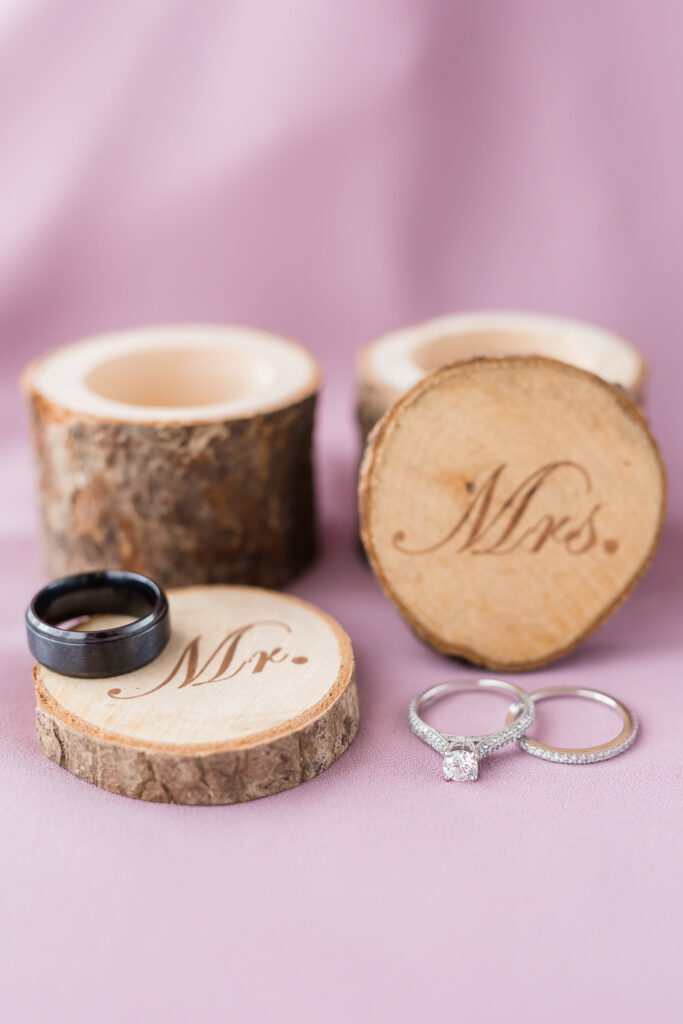
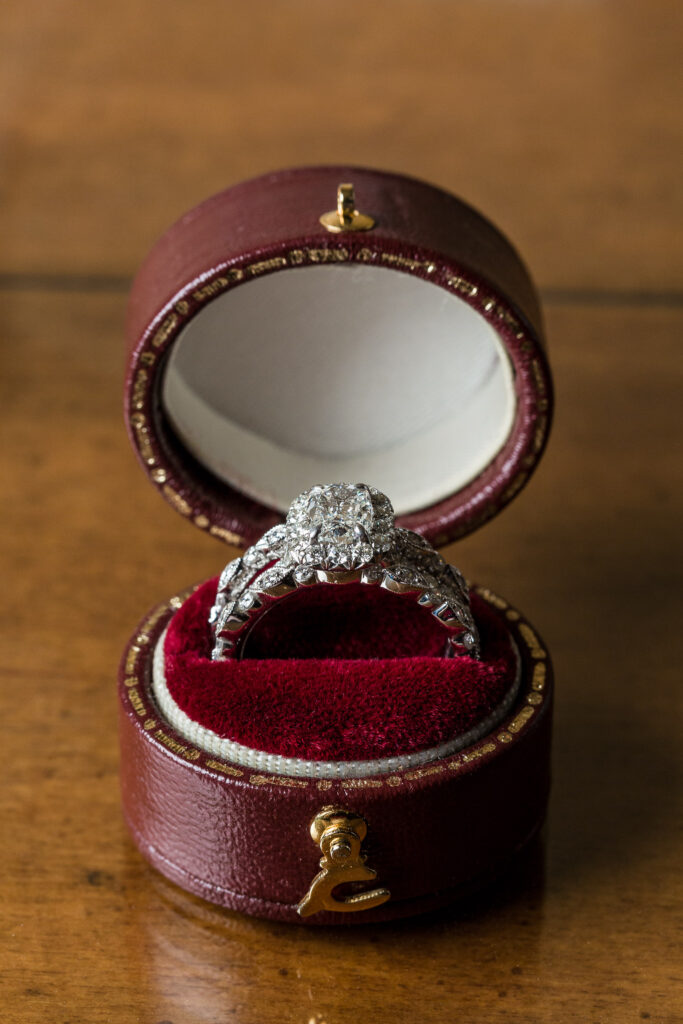

Happy Ring Hunting
So there you have it, the full spectrum of how to choose a diamond. One that’s more than just a stone, but a testament to your unique journey together. It’s clear that this isn’t just about picking a gem; it’s about finding a piece that truly resonates with you, your story and symbolizes the love and commitment you share.
As you make this decision, remember, that it’s the thought, the love, and the meaning behind the ring that truly defines its value. Let it be a reflection of your bond, a symbol of enduring love that stands the test of time.
And hey, if you ever want to talk more about diamonds, need a bit more guidance, or just feel like sharing the happiness of your choice, don’t hesitate to reach out! As a seasoned Dallas wedding photographer, I’m always excited to get to help in any capacity that I can. This is such an exciting season and I’m thrilled to celebrate right alongside you!
Until next time, happy ring hunting!
Paragraph
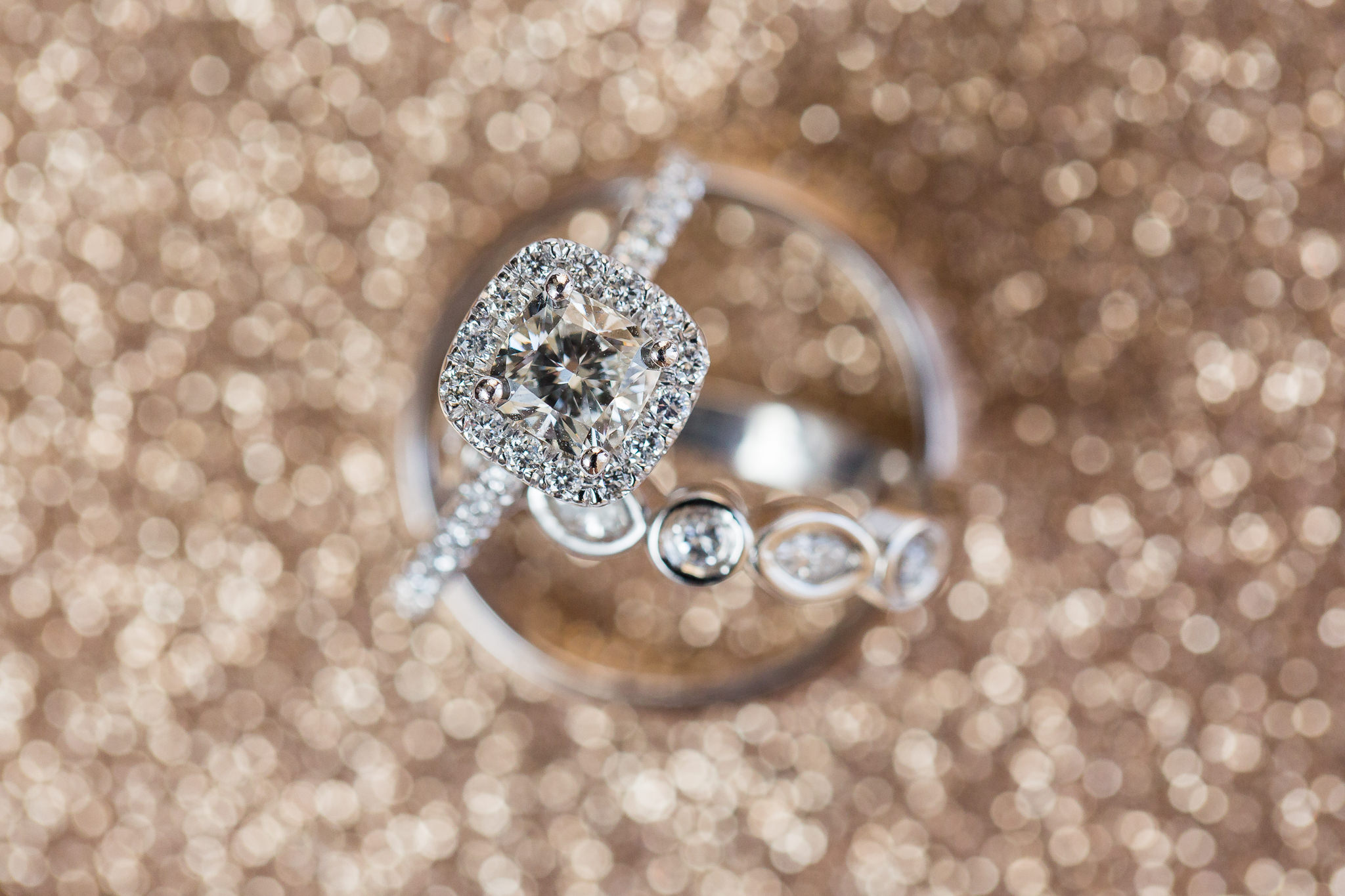
+ SHOW COMMENTS
- Hide Comments
add a comment